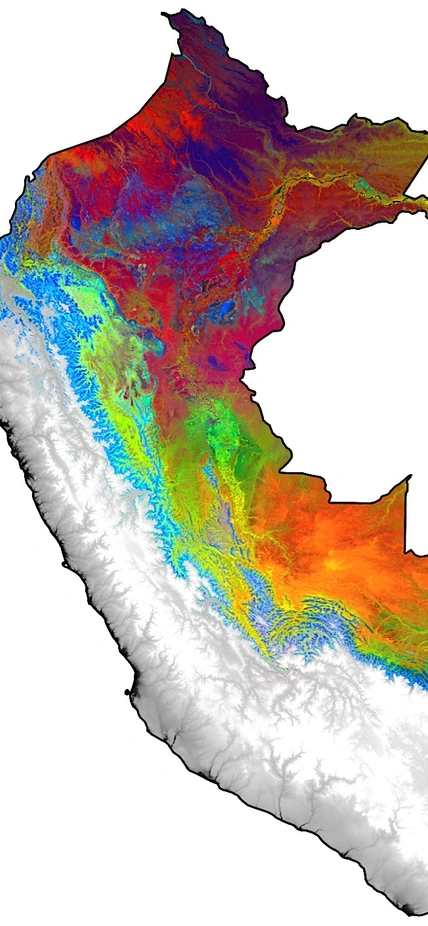Washington, DC— It turns out that forests in the Andean and western Amazonian regions of South America break long-understood rules about how ecosystems are put together, according to new research led by Carnegie’s Greg Asner and published in the Proceedings of the National Academy of Sciences. Their findings could help scientists understand how tropical forests will respond to global climate change.
One of forest ecology’s fundamental undertakings has long focused on how tree growth is influenced by a host of environmental factors ranging from soils and elevation to hydrology and climate. These factors create an economy of resources that the trees must exploit through different strategies, some of which are optimized for quick growth while others favor slow growth.
More than a decade ago, ecologists established a framework to measure and quantify the calculus between fast- and slow-growth strategies among plant species. The idea was simple:
Some plants are like high-rollers looking for the quickest-possible returns, which comes in the form of highly efficient photosynthesis—the process by which plants use the Sun’s energy to store carbon. These types of plants have been associated with environments that supply high concentrations of essential nutrients, such as nitrogen and phosphorous, and warm-wet climatic conditions, both of which help plants photosynthesize more productively.
Other plants are like prudent savers that invest in long-term infrastructure, meaning growing leaves with strong internal structures and increased mass that are designed to live for a long time. These structural investments allow more photosynthesis to be accomplished per leaf over the plant’s lifetime. This strategy is thought to be employed by longer-living plants in areas where nutrients are scarcer, or where climates are colder or drier.
To understand the tradeoffs between these high-roller and prudent investor strategies, ecologists often plot leaf nutrients in comparison to leaf mass per area in response to different environmental factors. This is a particularly useful approach for understanding how to predict forest physiological responses to changing environmental conditions, including climate.
However, until now, this “leaf economics” approach has never been studied on large geographically continuous scales.
Using a unique, high-fidelity imaging spectrometer onboard the Carnegie Airborne Observatory, Asner and his team made the first-ever forest canopy maps of leaf nitrogen, phosphorous, and mass over a large portion of the biosphere covering nearly 200 million acres of Peru.
“We tested a traditional ecological principle at a completely new scale—in this case, the vast and under-explored Andes and Amazon region,” Asner explained.
They discovered that the leaf economics of forests are not as straightforward as scientists once believed.
“We found that Andean and Amazonian forests have evolved into diverse communities that break simple ecological ‘rules’ previously developed through field-based studies. These forests are actually much more interesting and functionally diverse than previously thought, and have sorted themselves out across a variety of environmental templates like geology, elevation and temperature,” Asner added.
It turns out the forests aren’t so simply split between high-rollers and prudent investors either. Rather the authors found a continuum of forest canopy nitrogen, phosphorous, and leaf mass relationships that are sensitive to the enormous range of geophysical conditions found throughout the region.
Why do these findings matter?
The team believes that the mapped continuum of factors mediating tree growth in response to the environment will play a key role in determining how these forests will respond to climate change. Understanding these relationships is crucial to figuring out how to project changes in Andean-Amazonian forests using the next generation of climate models.
“These findings also make a clear case for taking our airborne science to Earth orbit as a satellite mission. This is the only way to create new global-scale maps, which are needed to better understand these ecological processes and to predict the roles they will play in Earth’s future,” Asner said.
Image Caption: Tropical rainforests of the Andes and western Amazon basin are often viewed as being similar in their growth properties, but new airborne spectroscopic measurements reveal a different pattern. Colored portions of this map of Peru indicate differences in tropical forest canopy chemicals that control tree growth. Each color reveals a different chemical makeup among Andean and Amazonian trees that are tightly related to the underlying geology, elevation and climate. Orange and red colors indicate relatively higher nitrogen concentrations in tree canopies, while green colors indicate higher phosphorus, and blues indicate thicker and tougher leaves. All other colors indicate the continuous nature of these trade-offs. These differences have a big role to play in predicting forest growth under changing climate conditions. Image is provided courtesy of Greg Asner.
__________________
This study was funded by the John D. and Catherine T. MacArthur Foundation.
The Carnegie Airborne Observatory is currently supported by the Avatar Alliance Foundation, the John D. and Catherine T. MacArthur Foundation, Mary Anny Nyburg Baker and G. Leonard Baker Jr., and William R. Hearst III.
